|
|
|
Sort Order |
|
|
|
Items / Page
|
|
|
|
|
|
|
| Srl | Item |
| 1 |
ID:
120606
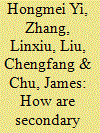

|
|
|
|
|
| Publication |
2013.
|
| Summary/Abstract |
Drawing on a survey of 106 secondary vocational schools and 7309 students in two provinces of China, this descriptive paper assesses whether vocational schooling is measuring up to government benchmarks for quality and whether poor students are able to access quality schools. We find that secondary vocational schools have met government benchmarks for teacher qualification and training, student opportunities for practical training and adequate facilities. Furthermore, poor students access schools of similar quality to non-poor students, even though 34 percent of poor students do not receive financial aid. We conclude that recent policies are successfully ensuring secondary vocational school quality and equity of access to school quality between poor and non-poor students. However, financial aid policies should be re-examined, such that poor students receive sufficient coverage. Moreover, given that input-based measures only proxy school quality, the government should consider holding schools accountable for outcomes such as student learning.
|
|
|
|
|
|
|
|
|
|
|
|
|
|
|
|
| 2 |
ID:
144155


|
|
|
|
|
| Summary/Abstract |
This paper describes recent research on cost indexes by the Institute for Defense Analyses. It was performed at the request of the Cost Assessment and Program Evaluation directorate in the Office of the Secretary of Defense to assist in meeting the requirement in the 2009 Weapon Systems Acquisition Reform Act to assess and update the cost deflators the Defense Department uses to adjust for price growth in costing and budgeting major systems. The paper’s focus is on aircraft procurement. The research analyzes deflator algorithms and data to determine the source of the wide differences in aircraft cost growth rates calculated by (a) the Gross Domestic Product deflator for the entire US market basket of goods and services, (b) the national defense index for military aircraft published by the Bureau of Economic Analysis, and (c) the Producer Price Index for civilian aircraft published by the Bureau of Labor Statistics. The study demonstrates an alternative hedonic approach for calculating price indexes by using regression analysis to relate aircraft investment cost to the aircraft’s specific physical and operational design features such as weight and speed.
|
|
|
|
|
|
|
|
|
|
|
|
|
|
|
|
| 3 |
ID:
086698
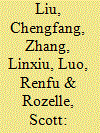

|
|
|
|
|
| Publication |
2009.
|
| Summary/Abstract |
Although quality may be as important as quantity in public infrastructure management, little research has studied changes in the quality of China's infrastructure investments. This study seeks to document the quality of infrastructure projects in China's villages and to measure whether or not quality has suffered as China's investment effort has risen. The study also examines if satisfaction is rising. Using data from 100 villages in China, we have found that both the quantity and the quality of infrastructure investments have increased. We also find that rural residents are more satisfied with projects, especially when they are higher quality.
|
|
|
|
|
|
|
|
|
|
|
|
|
|
|
|
| 4 |
ID:
192421
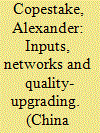

|
|
|
|
|
| Summary/Abstract |
This paper exploits China's accession to the WTO to investigate the impact of a supply shock on quality across the Indian production network. After controlling for increased import competition, including in downstream and third-country markets, and for new export opportunities, we find that a fall in input tariffs raises revenue, quality and prices, whilst lowering quality-adjusted prices and the probability of product exit – consistent with a simple model of multi-product manufacturers gaining access to higher-quality components. Upgrading persists for at least ten years; at the peak in 2010, products with a 10% higher pre-accession input tariff, and hence a larger post-accession fall in tariffs, have 5.3% higher quality. This in turn raises quality further down the supply chain, with input-output linkages amplifying the one-step effect by up to 75%. These results highlight a potential beneficial impact of the “China shock” in developing countries, namely supply-driven quality upgrading.
|
|
|
|
|
|
|
|
|
|
|
|
|
|
|
|
| 5 |
ID:
188414
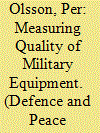

|
|
|
|
|
| Summary/Abstract |
This article aims to present and discuss a method for estimating military equipment quality, while also comparing this approach to previous methods developed with the same purpose. Using main battle tanks as an example, the suggested method’s structure and preliminary results are presented while its potential merits and limitations are also discussed. Preliminary results of the method show that US and western European tanks have traditionally had an qualitative edge. However, they also suggest that modern Russian and Chinese tanks have narrowed this gap. Equipment performance models, such as the one presented in this article, could provide additional insights when assessing the global and regional power balances as well as when estimating purchasing power parities and equipment cost escalation. This article will hopefully encourage further discussion on how to measure and compare military equipment quality.
|
|
|
|
|
|
|
|
|
|
|
|
|
|
|
|
| 6 |
ID:
138193
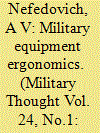

|
|
|
|
|
| Summary/Abstract |
The author addresses a subject at the forefront of many people's minds - making humans feel comfortable with the automated control systems of a warship, its armaments, weapons, and equipment - in the sense of how ergonomic they are in the human environment and how well military equipment is integrated into this environment all the way from design to operation.
|
|
|
|
|
|
|
|
|
|
|
|
|
|
|
|
| 7 |
ID:
143394
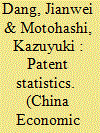

|
|
|
|
|
| Summary/Abstract |
Using a merged dataset of Chinese patent data and industrial survey data, we make a bibliometric analysis of patenting activities of Chinese large and medium-sized enterprises under local patent subsidy programs and test whether patent statistics are a good indicator of innovation in China. Our empirical results show that patent count is correlated with R&D input and financial output, which suggests that patent statistics are meaningful indicators. However, patent subsidy programs increase patent counts more than 30%. We emphasize the necessity of adjustments and provide a novel method of using the number of nouns in claims to quantify the claim scope, thereby overcoming the shortcomings of Chinese patent data that have no citations or lack well-documented patent claim information. We extend prior studies on patent subsidy programs by providing a detailed clarification of policy designs and their impacts and by evaluating policy impacts on both the quantity and quality of patent applications.
|
|
|
|
|
|
|
|
|
|
|
|
|
|
|
|
| 8 |
ID:
112083


|
|
|
|
|
| Publication |
2012.
|
| Summary/Abstract |
Why is there so much discontent about the current plans to reform the National Health Service in England? What is the government trying to do, and are the critics right to want to block reform? This paper traces the genesis of the current proposals in the Health and Social Care Bill, currently in the Lords, and why the Government has had to water down significant parts of it to appease the critics. The paper argues that the case for change has not been made to public or the 1.3 million staff in the NHS, the extent and timing of the reform is far from ideal given the need to make unprecedented efficiencies in the NHS, and that the political process to gain support has been weak. Yet many elements of the Bill push the NHS in the right direction, and without effective reform the original settlement-to provide equal access to care on the basis of need-is put at risk.
|
|
|
|
|
|
|
|
|
|
|
|
|
|
|
|
| 9 |
ID:
162420
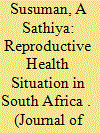

|
|
|
|
|
| Summary/Abstract |
South Africa is still lagging behind with health outcomes, especially when it comes to accessing treatment, prevention and care for reproductive health issues despite the significant progress made with regard to certain aspects of the health system. This study explores the reproductive health situation in South Africa. The study explores some selected health outcomes and related policies from the nine provinces in South Africa. The results indicate that, despite the progress made in the fight against HIV/AIDs and other health-related problems, little has been done to improve maternal health care.
|
|
|
|
|
|
|
|
|
|
|
|
|
|
|
|
| 10 |
ID:
132404
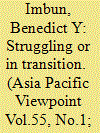

|
|
|
|
|
| Publication |
2014.
|
| Summary/Abstract |
The challenge of ensuring economic opportunities are made available to a country's population is a key function of any government. It is particularly acute in many developing countries where the subsistence economy is dominant and where limited formal employment opportunities exist. For such countries, reliance on cash cropping provides a central plank in earning foreign exchange. More importantly, it provides an important source of cash incomes for the largely subsistence-based population. Papua New Guinea (PNG) is one such example with a significant rural population dependent on cash crops for their economic livelihood. This paper discusses the country's coffee industry in the context of its producers, most importantly the contribution made by small household growers, and the issues and challenges they face. The paper traces the emergence of coffee as a cash crop in the PNG highlands and discusses, among other things, recent developments in extension and points out possibilities for government intervention to ensure the continued viability of the highlands coffee industry. Conceptually, the discussion acknowledges the significance of relational economics and its underpinnings, particularly reflections of duality of labour, perceptions of coffee as cash crop and markets in the context of Indigenous growers.
|
|
|
|
|
|
|
|
|
|
|
|
|
|
|
|
| 11 |
ID:
140259


|
|
|
|
|
| Summary/Abstract |
This paper examines how workplace goals affect the quality of worker output, using data from the recruiting command of the US Navy. Recruiting stations and recruiters are assigned monthly goals for the quantity of new recruits that may create an unintended incentive to sacrifice quality, especially towards the end of the month. Using data on the universe of Navy recruits from FY1998 to 2010, we find significant reductions in the quality of recruits towards the end of the contracting month, both in terms of pre-existing quality of recruits and in medium-term outcomes that reflect the quality of the job match.
|
|
|
|
|
|
|
|
|
|
|
|
|
|
|
|
|
|
|
|
|